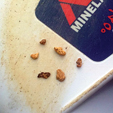Prospecting & Detecting
The Rest of the Story—Detecting With Ray Mills
December 2018 by Scott Harn
 Ray followed up by detecting the same area and I was happy to see that he did not find any good targets in the same line. So far so good.
Ray followed up by detecting the same area and I was happy to see that he did not find any good targets in the same line. So far so good.
Fluorescent Mineral Prospecting
 Ultraviolet light is divided into three levels, labeled A, B and C depending on the wavelength, with C having the shortest wavelength and the most energy.
Ultraviolet light is divided into three levels, labeled A, B and C depending on the wavelength, with C having the shortest wavelength and the most energy.
The Historic Gold Rush Town of Quincy
 …we focused on various layers of hard-packed flood material out of the creek, and we also obtained some material up quite a ways from the creek itself on bedrock.
…we focused on various layers of hard-packed flood material out of the creek, and we also obtained some material up quite a ways from the creek itself on bedrock.
Achieving Accurate Metal Detector Discrimination
 Your odds of going home with gold will be higher using the discrimination mode, even if you might have misread one of the targets you rejected.
Your odds of going home with gold will be higher using the discrimination mode, even if you might have misread one of the targets you rejected.
Falcon Fanatic: Journey of a Novice Detectorist
 My first day using my pinpointer I detected an area where the fellas’ big guns had swooped in and cleaned up all the “big gold” and I got over sixty tiny pieces of gold.
My first day using my pinpointer I detected an area where the fellas’ big guns had swooped in and cleaned up all the “big gold” and I got over sixty tiny pieces of gold.
The Coolgardie Gold Mining Camp of Southern California
 The area was mined intermittently from around 1900 to 1915, but was also mined in the late 1800s, with a total output valued at about $100,000, which is around $9.5 million at the current gold price.
The area was mined intermittently from around 1900 to 1915, but was also mined in the late 1800s, with a total output valued at about $100,000, which is around $9.5 million at the current gold price.
Gold Detecting Strategies for Hydraulic Mines and Debris Flows
 The old timers typically washed these areas down to bedrock, and some areas appear terraced. I would imagine this is because these hydraulic mines were generally where the miners found old Tertiary river channels on the sides of mountains that were gold-bearing.
The old timers typically washed these areas down to bedrock, and some areas appear terraced. I would imagine this is because these hydraulic mines were generally where the miners found old Tertiary river channels on the sides of mountains that were gold-bearing.
Subscription Required:
The Bawl Mill
• Legislative and Regulatory Update
• Ask The Experts - LR 2000, ArcGIS, and other mapping applications
• Ask The Experts - Advice for a new prospector in Placerville, California?
• Placer Gold Deposits of Utah
• Proven Strategies for Detecting Gold
• Gold Prospecting for Better or Worse: Lesson Learned
• Time to Come Home
• Gold Indicators—What to Look for in the Goldfields
• Gold and Mining Stocks Will Rebound—But When?
• Melman on Gold & Silver
• Mining Stock Quotes and Mineral & Metal Prices
Free:
Ask The Experts - Can a detonation help determine the size and location of basalt?
• On the fence about subscribing? Want to check out a 3D sample issue?
• Resurrecting An Old Hard Rock Mine
• PLP Update








